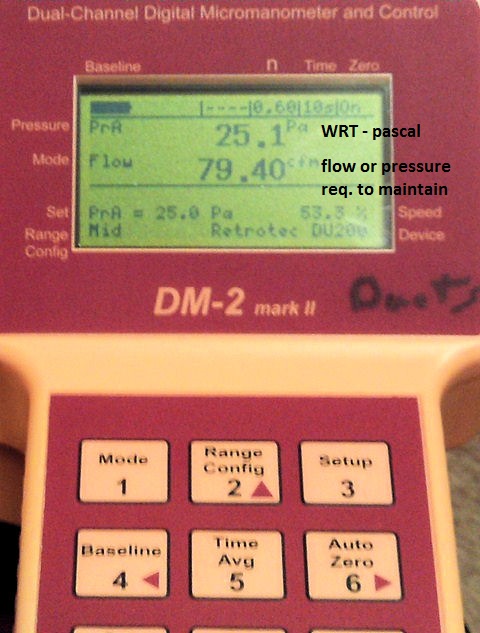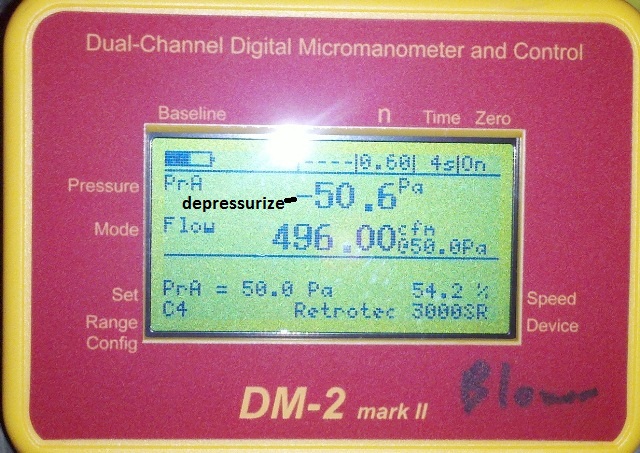 The pascal aka “Pa” is simply a unit used to measure pressure on a manometer. In this context, pressure (p) is the measurement of force acting on a unit area with respect to (WRT) another. One example is when we are testing an HVAC’s system ductwork; we pressurize the entire system to 25 pascals with respect to the house.
The pascal aka “Pa” is simply a unit used to measure pressure on a manometer. In this context, pressure (p) is the measurement of force acting on a unit area with respect to (WRT) another. One example is when we are testing an HVAC’s system ductwork; we pressurize the entire system to 25 pascals with respect to the house.
No matter where you are it in the world, the home performance & building science fields generally deal in pascals. This is because it not only works well with imperial & metric measurements but it also scales well for the testing needing to be done. (see ACH article for 1 example)
| Unit to pascal | 25 Pa | 50 Pa | 75 Pa |
| 1 atmosphere = 101,325 Pa | 0.000 247 | 0.000 49 | 0.000 74 |
| 1 bar = 100,000 Pa | 0.000 25 | 0.000 50 | 0.000 75 |
| 1 PSI = 6,894.76 Pa | 0.003 63 | 0.007 25 | 0.0108 |
| 1 in Hg = 3,386 Pa | 0.007 | 0.015 | 0.022 |
| 1 in H2O = 249 Pa | 0.10 | 0.20 | 0.30 |
| 1 mm Hg = 133 Pa | 0.19 | 0.38 | 0.56 |
| 1 millibar = 100 Pa | 0.25 | 0.50 | 0.75 |
| 1 PSF = 47.88 Pa | 0.52 | 1.05 | 1.56 |
The chart above was split into 4 distinctive fields as an example of why some of the other well-known measurements don’t scale as well. The first column shows a single unit & how many pascals it contains while the three on the right show the most common testing units.
To pressurize or depressurize that is the question… While there are many schools of thought on this the most popular are as follows with the reasoning;
- 25 Pa is generally used for duct testing where we pressurize the whole system – this helps prevent contaminates from getting into the system & prevents false readings from tape or something similar from being sucked down & covering the leakage area
- 50 Pa is the generally used for performing air leakage testing on houses and buildings
- The most common method is to depressurize the house allowing for one to test how leaky the house is when it is windy.
- Pressurizing the house is generally only used if it is raining outside (and we wouldn’t be pulling moisture in) or there might be an IAQ issue & we would not want to pull any of those containment’s into the building. In a perfect world those issues would be addressed first but that is not always possible & testing might be required to get them remediated
- 75 Pa is mainly a military / specialty specification that generally requires both pressurizing & depressurizing the building (though that is not always required). For more on these procedures
 The French are it again… The International System of Units aka Le Système International d’Unités or SI is responsible for how items are displayed. The SIwas established back in 1960 during the by the 11th Conférence Générale des Poids et Mesures. The French are it again… The International System of Units aka Le Système International d’Unités or SI is responsible for how items are displayed. The SIwas established back in 1960 during the by the 11th Conférence Générale des Poids et Mesures.
Another interesting item is how the numbers are displayed in the table above. As you can see any time a number exceeds 4 digits to the left or right of the decimal point, a space should be added after the third digit. For more on this, you might want to check out the NIST pages on this. NIST & SI Unit rules |




Wow! I didn’t know about the space with the digits over 4. Something new everyday!
Thanks for chiming in & shoot, I actually stumbled on that yesterday when double checking my facts
Wow! I didn’t know about the space with the digits over 4. Something new everyday!
Thanks for chiming in & shoot, I actually stumbled on that yesterday when double checking my facts